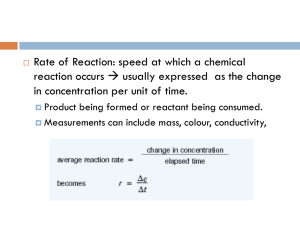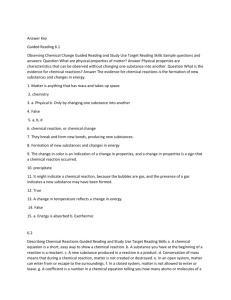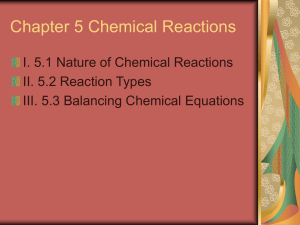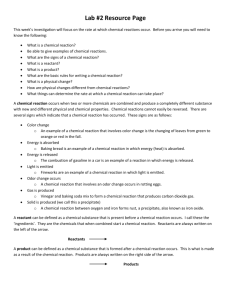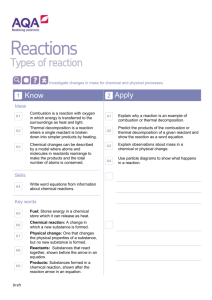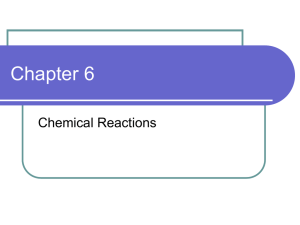Chemical Equations
advertisement
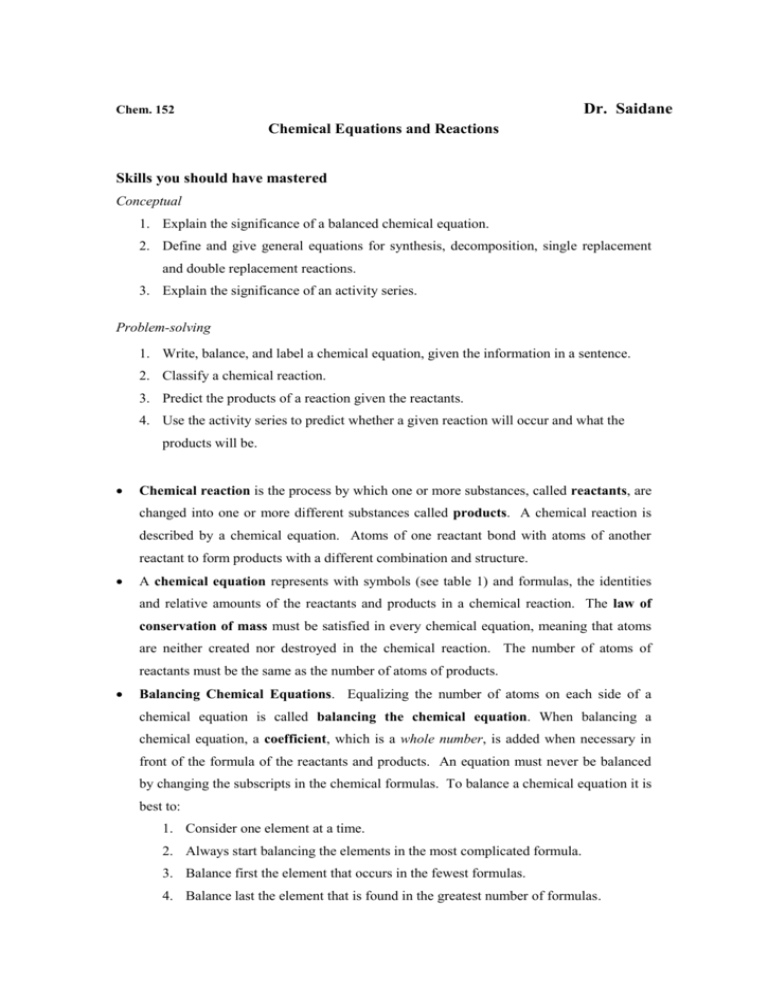
Dr. Saidane Chem. 152 Chemical Equations and Reactions Skills you should have mastered Conceptual 1. Explain the significance of a balanced chemical equation. 2. Define and give general equations for synthesis, decomposition, single replacement and double replacement reactions. 3. Explain the significance of an activity series. Problem-solving 1. Write, balance, and label a chemical equation, given the information in a sentence. 2. Classify a chemical reaction. 3. Predict the products of a reaction given the reactants. 4. Use the activity series to predict whether a given reaction will occur and what the products will be. Chemical reaction is the process by which one or more substances, called reactants, are changed into one or more different substances called products. A chemical reaction is described by a chemical equation. Atoms of one reactant bond with atoms of another reactant to form products with a different combination and structure. A chemical equation represents with symbols (see table 1) and formulas, the identities and relative amounts of the reactants and products in a chemical reaction. The law of conservation of mass must be satisfied in every chemical equation, meaning that atoms are neither created nor destroyed in the chemical reaction. The number of atoms of reactants must be the same as the number of atoms of products. Balancing Chemical Equations. Equalizing the number of atoms on each side of a chemical equation is called balancing the chemical equation. When balancing a chemical equation, a coefficient, which is a whole number, is added when necessary in front of the formula of the reactants and products. An equation must never be balanced by changing the subscripts in the chemical formulas. To balance a chemical equation it is best to: 1. Consider one element at a time. 2. Always start balancing the elements in the most complicated formula. 3. Balance first the element that occurs in the fewest formulas. 4. Balance last the element that is found in the greatest number of formulas. 5. Balance last the element that occurs in the least complicated formula. Classifying Chemical Reactions There are several different ways to classify chemical reactions. In this course chemical reactions are classified as follows: a) Combustion Reactions. In a combustion reaction, a substance containing C, H, and sometimes O, combines with oxygen gas from air, releasing a large amount of energy and light. The products are carbon dioxide (CO2) and water liquid. b) Combination Reactions. Also called synthesis. Two or more substances, which can be elements or compounds, combine to form a new compound. This type of reaction is represented by the following general equation: A + X AX c) Decomposition Reactions. In a decomposition reaction, a single compound undergoes a reaction that produces two or more simpler substances, which can be elements or compounds. Decomposition reactions are the opposite of synthesis reactions and are represented by the following general equation: AX A + X d) Single Replacement Reactions, also known as displacement reactions. In these reactions, one element replaces a similar element in a compound. A metal replaces a metal and a nonmetal replaces a nonmetal. They can be represented by the following general equation: A + BX AX + B or Y + BX BY + X A, B, X, and Y are elements, AX, BX, and BY are ionic compounds. Single replacement reactions are also called oxidation-reduction reactions, in which one element in the reactants loses electrons, and the other gains electrons. Single Replacement Reactions can be predicted using the activity series. An activity series is a list of elements organized according to the ease with which the elements undergo certain chemical reactions (See table 2). e) Double Replacement Reactions. In these reactions, the ions of two reactants exchange places in an aqueous solution to form two new products. One of the compounds formed is usually a precipitate (ionic compound insoluble in water), an insoluble gas that bubbles out of the solution, or a molecular compound that is usually water. If the compound formed is insoluble in water, it is called a precipitate, and the reaction is a precipitation reaction. The formation of a precipitate can be predicted using the solubility chart of ionic compounds. If the reactants are an acid and a base, the reaction is an acid-base reaction, and one of the products is water. The general equation for double replacement reactions is: AB + CD AD + CB; A and C are cations, and B and D are anions. Table1. Symbols used in chemical equations Symbol Explanation “yields”; indicates result of reaction. Used in place of a single arrow to indicate a reversible reaction. (s) A reactant or product in the solid state; also used to indicate a precipitate. Alternative to (s), but used only to indicate a precipitate. (l) A reactant or product in the liquid state. (aq) A reactant or product in an aqueous solution (dissolved in water). (g) A reactant or product in the gas state. Alternative to (g), but used only to indicate a gaseous product formed. heat or 2 atm Pressure Reactants are heated. Pressure at which reaction is carried out, in this case 2 atm. Pressure at which reaction is carried out exceeds normal atmospheric pressure. 0 C Temperature at which reaction is carried out, in this case 0C. Pt Formula of catalyst, in this case Platinum, used to alter the rate of the reaction. Table 2. Activity Series of the Elements Activity of Metals Li Rb K Ba Sr Ca Na Mg Al Mn Zn Cr Fe Cd Co Ni Sn Pb H2 Sb Bi Cu Hg Ag Pt Au Activity of Nonmetals F2 Cl2 Br2 I2 React with cold water and acids, replacing hydrogen. React with oxygen forming oxides. React with steam (but not with cold water) and acids, replacing hydrogen. React with oxygen, forming oxides Do not react with water. React with acids, replacing hydrogen. React with oxygen, forming oxides. React with oxygen forming oxides Fairly unreactive, forming oxides only indirectly.


